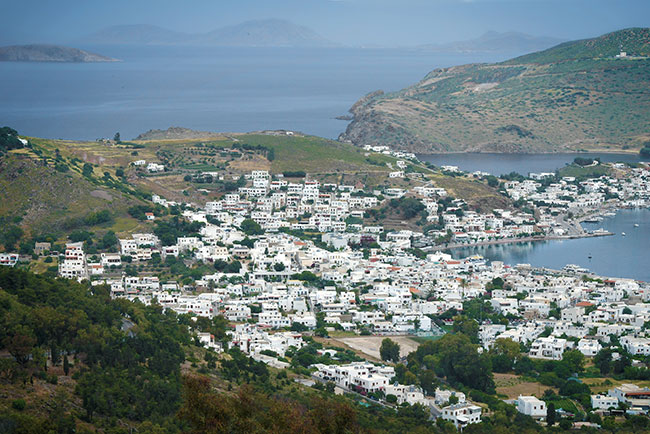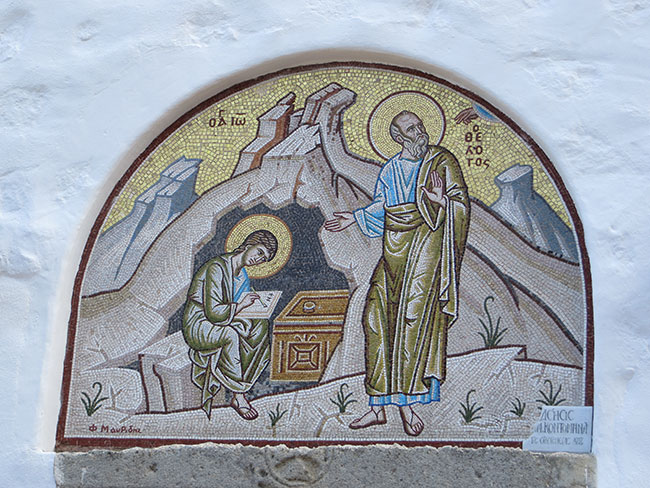CHI’s Pilgrimage to Biblical Turkey and Greece: Part 2 John’s Revelation on Patmos
CHI’s Pilgrimage to Biblical Turkey and Greece: Part 2 John’s Revelation on Patmos
The book of Revelation is full of wild and disturbing images: Jesus with a sharp two-edged sword coming out of his mouth (1:16); a rainbow that shines like an emerald (4:3); living creatures with six wings and eyes all around even under the wings (4:8); and a beast from the sea with seven heads and ten horns (13:1), to name a few. For centuries, people have been trying to make sense of this book. We know how to read gospels and epistles, but when it comes to Revelation, Christians typically either dismiss it or debate it. It is Scripture, and yet we often experience it more like a problem than like good news.

(Photos courtesy of Christian History's design editor, Doug Johnson)
Patmos is the (modern-day Greek) island on which John received the Revelation and wrote it down (Rev. 1:9). We took a four-hour ferry ride across the beautiful Aegean Sea to get there.On the way, we read Revelation aloud. My husband, Jacob, and I took turns shouting the words over the roar of the ferry’s motor. Reading Revelation aloud on the Aegean Sea brought the words to life in a way that reading them silently in my bedroom never has. I wasn’t just reading about the throne room of God; it was like we were there with the elders and angels praising God aloud.
I learned that Revelation is a book of worship. I learned this both through experience and through good teaching. I needed to shout the words of Revelation to feel the intensity of the praise through the entire book. I also needed some good teaching, which the seminary professor on our trip provided, to help me make sense of the many symbols from another time and culture.
Revelation urges the churches in places we had visited (e.g. Ephesus, which I explored in Part 1 of this blog series) to remain faithful to Jesus and to bear witness to Jesus. As we read, I found myself crying out, “Worthy is the Lamb that was slaughtered to receive power and wealth and wisdom and might and honor and glory and blessing!” (Rev. 5:12). These words sound and feel very different when you shout them rather than reading them silently. Try it!

Somewhere around Revelation 19, the ferry arrived. We cut our reading short. My aching throat was grateful. We climbed off the ferry and into a large tour bus, which carried us up through the hills to the Cave of the Apocalypse. The cave where tradition says John received the Revelation has been built into an Orthodox chapel. My head spun a little as I took in the contrast between the staggering beauty of this chapel and John praying in this simple cave on an island full of exiles.

We gathered together in the few rows of chairs and read the final two chapters of Revelation. We imagined the new heavens and new earth as we looked out the chapel windows toward the sea. We sang a hymn and prayed a prayer. We worshiped the God who promises to make all things new. We said with John, “Amen. Come, Lord Jesus!” (Rev. 22:20).
As we read the whole book in one day, I allowed the unfamiliar images and symbols wash over me (some of them make sense to me after some good teaching; others I have yet to learn about). I could hear the whole book as a vision of worshipping Jesus. If you take an hour and a half to read all 22 chapters, you may find, like I did, that many of the words are familiar. Many are found as lyrics in our contemporary worship songs.

Revelation is still a difficult book. The symbols come from long ago and take a lot of work to understand. But reading the whole book in the place where it was first written, I found that Revelation is not a problem. Revelation is a gift. It encourages us to remain faithful to Jesus no matter what we face. And it promises a future in which God makes all things new and Jesus himself is our light. We learned anew to shout with John, “Amen. Come, Lord Jesus!”
By Michelle Curtis
Take an exciting and informative video journey with actor David Suchet to the Seven Churches of Revelation! Subscribe to get future issues of Christian History magazine, with or without a donation.
Read Part 1 of this series to explore CHI’s journey in Ephesus. Read part 3 of this series, Biblical art



